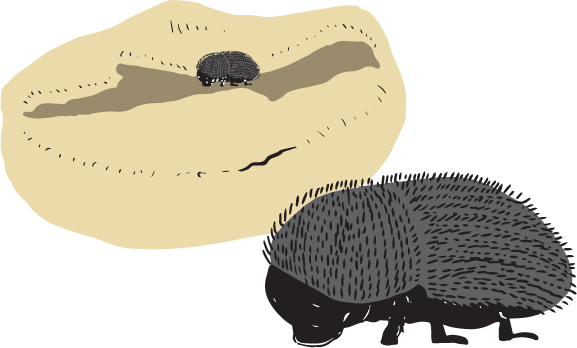MORE ABOUT COFFEE GROWING
So we’ve covered the basics with our look at the life cycle of the coffee plant. But there are also all kinds of details and practicalities to be considered when it comes to coffee cultivation.
Propagation
There are two ways of propagating new coffee plants: by taking cuttings or by sowing the seeds.
Cuttings
This involves cutting off a small piece of the coffee plant (the tip of a branch with two leaves on it, and each leaf cut in half) and planting it. When new leaves and roots form, the cutting has taken, and develops in the same way as a seedling. Since taking cuttings is a form of cloning, each new plant will be genetically identical to the plant from which the cutting was taken.

COFFEE CUTTING
Seeds
To obtain seeds for planting, coffee cherries are selected at full maturity, as this gives the best chances of germination. They are pulped and left to ferment for a short time (less than ten hours) before being dried and prepared for planting. The seeds are sown in containers, often polyethylene bags, in compost conducive to the growth of the young coffee plant (crumbly, light texture, fertile).
In nurseries
Seedlings and cuttings are generally grown in nurseries, rather than on a plantation itself, so as to provide a controlled, better protected environment (shelter, shade, irrigation). When the young plants are strong enough and have grown to a height of between 15 and 25 inches, with about ten pairs of leaves, they can be transplanted into the fields to continue growing.

NURSERY ON A COFFEE PLANTATION

Coffee flavors by altitude
The cooler climate at high altitude causes the cherries to ripen more slowly, resulting in denser beans. Broadly speaking, this means that the higher the altitude at which the coffee is growing, the greater its acidity, the fuller its aromas, and the better its taste.

THE INFLUENCE OF ALTITIUDE ON THE FLAVOR:
5,000–6,500 FT: FLORAL, SPICY, FRUITY, ACIDIC, GREATER COMPLEXITY
4,000–5,000 FT: WELL-DEVELOPED ACIDITY, MORE AROMAS
3,300–4,000 FT: LOW ACIDITY, ROUNDNESS
2,600–3,300 FT: NO ACIDITY, LITTLE COMPLEXITY
Growing organic coffee
Organic farming is relatively rare in coffee-producing countries, where the use of pesticides is the norm. Unfortunately, from a flavor perspective, organic cultivation does not enhance the quality of the brew. Therefore, flavor does not count as a reason for a farmer to change his approach. However, in some countries like Ethiopia, small-scale growers do not use any inputs because they are too expensive, which means that they practice organic farming by default, without being officially certified. In Brazil, the world’s number one coffee-producing country, some producers, like Fazenda Ambiental Fortaleza, grow coffee by organic methods.
Enemies of the coffee plant
There are various natural organisms that attack Coffea arabica, but its two biggest enemies are the fungus that causes coffee leaf rust (Hemileia vastatrix), and the coffee borer beetle (Hypothenemus hampei).
Coffee leaf rust
Discovered in Sri Lanka in the nineteenth century, coffee leaf rust is now found in virtually all coffee-producing countries. It attacks the leaves during rainy periods, preventing photosynthesis and even causing the leaves to drop off. The coffee plant is weakened and its growth may come to a halt. To combat this disease, which takes a heavy toll on a harvest, growers can opt for more resistant hybrid varieties.

A LEAF AFFECTED BY COFFEE LEAF RUST
The coffee borer beetle
The coffee berry borer is a small beetle (the female is 2.5 mm long and the male, 1.5 mm). Originally from Africa, today it is found in most of the coffee-producing countries. The female bores tunnels in the coffee cherries while they are still green and lays her eggs in them. The larvae then feed on the seeds contained in the cherry.

A COFFEE BORER BEETLE